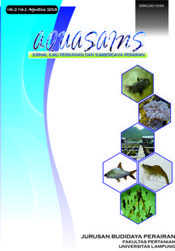APLIKASI BUNGKIL INTI SAWIT MELALUI PEMBERIAN ENZIM RUMEN DAN FERMENTASI SEBAGAI BAHAN PAKAN IKAN NILA BEST (Oreochromis niloticus)
Abstract
An important factor on tilapiaaquaculture (Oreochromis niloticus) is
the availability of food in sufficient quantity,
unfortunetely soybean meal and fish
oil as feed ingredients are imported. Alternative
feedstuffs needed to solve the problem
of limited soybean meal. Indonesia is
the largest producer of palm oil by-product
called palm kernel meal (PKM). The study
was conducted to determine the effect of
the addition of rumen enzyme and fermentation
on nutrient digestibility determines
the level of PKM and PKM as a feed ingredient
for tilapia growth. This research used
completely randomized design with 7 treatments
and 3 replications. BEST tilapia with
total weight of 23.83 ± 1.39 g / fish were
used. Data were analyzed using analysis of
variance and followed by Duncan test. The
study shows that the use of BIS fermented
with rumen enzymes and Trichoderma reesei
provide the best nutrition and digestibility
compared to other treatments. Nutrient
content and digestibility of total protein
(83.73%), carbohydrate (65.46%), energy
(77.77%) and total digestibility (58%).
Downloads
Download data is not yet available.
Downloads
Published
2013-08-12
How to Cite
Putri, N. T., Santoso, L., & Samsudin, R. (2013). APLIKASI BUNGKIL INTI SAWIT MELALUI PEMBERIAN ENZIM RUMEN DAN FERMENTASI SEBAGAI BAHAN PAKAN IKAN NILA BEST (Oreochromis niloticus). AQUASAINS, 2(1), 53–56. Retrieved from https://jurnal.fp.unila.ac.id/index.php/JPBP/article/view/196
Issue
Section
Articles
License
License for Authors
Authors who publish with this journal agree to the following terms:
- Authors retain copyright and grant the journal right of first publication with the work simultaneously licensed under a Creative Commons Attribution License that allows others to share the work with an acknowledgement of the work's authorship and initial publication in this journal.
- Authors are able to enter into separate, additional contractual arrangements for the non-exclusive distribution of the journal's published version of the work (e.g., post it to an institutional repository or publish it in a book), with an acknowledgement of its initial publication in this journal.
- When the article is accepted for publication, its copyright is transferred to Aquasains Journal. The copyright transfer convers the exclusive right to reproduce and distribute the article, including offprint, translation, photographic reproduction, microfilm, electronic material, (offline or online) or any other reproduction of similar nature.
- Authors are permitted and encouraged to post their work online (e.g., in institutional repositories or on their website) prior to and during the submission process, as it can lead to productive exchanges, as well as earlier and greater citation of published work (See The Effect of Open Access).
- The Author warrant that this article is original and that the author has full power to publish. The author sign for and accepts responsibility for releasing this material on behalf os any and all-author. If the article based on or part os student’s thesis, the student needs to sign as his/her agreement that his/her works is going published.
License for Regular Users
Other regular users who want to cite, distribute, remix, tweak, and build upon author’s works, even for commercial purposes, should acknowledge the work’s authorship and initial publication in this journal, licensed under a Creative Commons Attribution License.
This license lets others distribute, remix, tweak, and build upon your work, even commercially, as long as they credit you for the original creation.
This work is licensed under a Creative Commons Attribution 4.0 International License.Copyright Transfer Statement can be downloaded here


.png)









